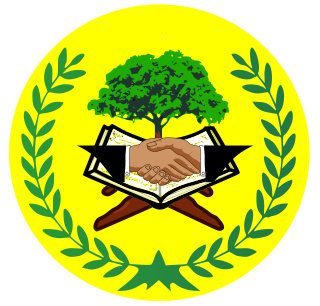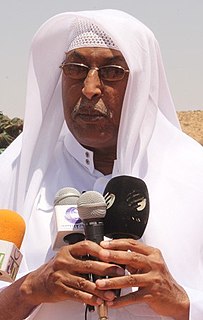
The president of Somalia is the head of state of Somalia. The president is also commander-in-chief of the Somali Armed Forces. The president represents the Federal Republic of Somalia, and the unity of the Somali nation, as well as ensuring the implementation of the Constitution of Somalia and the organised and harmonious functioning of the organs of state. The office of President of Somalia was established with the proclamation of the Republic of Somalia on 1 July 1960. The first president of Somalia was Aden Abdullah Osman Daar. Since his mandate expired on 16 February 2021 Mohamed Abdullahi Mohamed ‘Farmaajo’ has been acting president.

The coat of arms of Somalia was adopted on October 10, 1956 and was created by an unknown Somali man. The cheetahs which support the shield and the white star were also found on the coat of arms used in Italian Somaliland. Formerly, the arms of Somalia from June 8, 1919 featured a shield divided horizontally by a wavy white line. The top half of the shield was blue, with a cheetah in natural color surmounted by a white five-pointed star. Cheetahs are a common motif in Somali culture.

The Parliament of Somaliland consists of two chambers:

The House of Elders, also known as the Guurti, is the upper house of the Parliament of Somaliland. It has 82 members, representing traditional leaders. The House of Elders is mandated with considering bills proposed by the lower house of the parliament, the Somaliland House of Representatives.

Galmudug, officially Galmudug State of Somalia, is a Federal Member State in central Somalia, with its capital at Dhusamareb. It is bordered to the north by the Puntland state of Somalia, to the west by the Somali Region in Ethiopia, to the east by Indian Ocean and to the south by the Hirshabelle state of Somalia.

Adado is a city in the Galguduud region of Galmudug state in central Somalia.

The Federal Parliament of Somalia is the national parliament of Somalia. Formed in August 2012, it is based in the capital Mogadishu and is bicameral, consisting of an Upper House (Senate) and a Lower House. The tenth Parliament of Somalia was inaugurated on 27 December 2016. Since the constitutional mandate of the parliamentarians ended on December 27, 2020, Somalia now has no legitimate representative federal parliament.

Mahad Abdalle Awad is a Somali politician. He is the Second Deputy Speaker of the Federal Parliament of Somalia.

Himan and Heeb was an autonomous region in the Federal Republic of Somalia. Formed in 2008, its capital was the central town of Adado (Cadaado). In 2015 Himan and Heeb merged with Galmudug to form a much larger Galmudug which consists of Mudug and Galguduud regions.

Sir Nicholas Peter Kay is a British diplomat. He has served as the British ambassador to Afghanistan, Sudan and the Democratic Republic of the Congo. From 2013 to 2016 he was the United Nations Special Representative for Somalia.

Abdihakim Abdullahi Haji Omar, also known as Abdihakin Abdullahi Omar Amey, is a Somali politician. He was the Vice President of Puntland.
Ahmed Mohamed Gurase is a Somali politician. From January 2014 to January 2015, he served as the Minister of Education of Somalia. Ahmed Mohamed Gurase succeeded Maryam Qaasim when her post as Minister for Human Development and Public Services ended on 17 January 2014. The Ministry was split to allow the creation of 6 cabinet positions one of which was the Ministry of Education. The other 5 cabinet positions are Ministry of Health, Ministry of Culture and Higher Education, Ministry of Labour and Social Affairs, Ministry of Women and Human Rights, Ministry of Sports and Youth. On 12 January 2015, Ahmed Mohamed Gurase was succeeded by Abdullahi Ahmed Jama.
Central Regions State was a prospective autonomous region in the Federal Republic of Somalia.
Ali Mohamed or Ali Mohammed or Ali Mohammad may refer to:

The Somaliland Peace Process refers to the series of grassroot initiatives that brought peace to Somaliland after the collapse of central government of Somalia. In conjunction with the Somali National Movement, communities in Somaliland negotiated a series of truces to end hostilities and address the grievances between the communities who were often on opposing sides to the Barre regime.

The Somaliland Declaration of Independence was proclaimed on 18 May 1991 by Somali Sultans from the Isaaq, Dhulbahante, Issa, Gadabursi, Warsangali clans and the Somali National Movement.
Mohamed Abdullahi Moalim Aden, commonly known as Mohamed AdenTiiceey, is a Somali politician, founder and former president of the unrecognized autonomous state, Himan and Heeb.

Abdullahi Ali Mohamed(Barleh) is a Somali politician, second president of the unrecognized Himan and Heeb until the merger with Galmudug in 2015.

The Government of Somaliland (JSL) is the central government of Somaliland. The Government of Somaliland consists of legislative, executive, and judicial branches, each of which functions independently from the others. The Government runs under the framework established by the Constitution of Somaliland, adopted in 2001. It is a unitary state. The seat of the government is located in Hargeisa, the capital of Somaliland.

Presidential elections were held in Somaliland on 23 February 1997, the third indirect presidential election since the country declared its independence from Somalia in 1991. The elections took place towards the end of the Hargeisa Conference, held between October 1996 and February 1997. The election resulted in incumbent President Muhammad Haji Ibrahim Egal being reelected to a four-year term by a electoral college of elders who made up the national guurti(council of elders). Egal's closest competitor was Minister of Finance Suleiman Mohamoud Adan, who was also formerly in the cabinet of inaugural President Abdirahman Ahmed Ali Tuur.
















